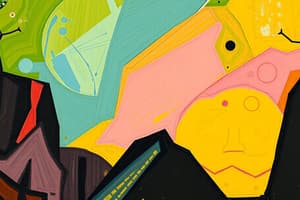Podcast
Questions and Answers
What does scarcity refer to in economics?
What does scarcity refer to in economics?
Deficient in quantity compared with demand; insufficient to satisfy unlimited needs and wants.
Which of the following is NOT one of the core principles of economics?
Which of the following is NOT one of the core principles of economics?
- Focus on Comparative Advantage
- Scarcity Implies Trade-Offs
- Bargaining Strength Comes Through Abundance (correct)
- Compare Costs + Benefits
What are the two types of economics discussed?
What are the two types of economics discussed?
Microeconomics and Macroeconomics
Positive economics prescribes how the world should be.
Positive economics prescribes how the world should be.
What is the opportunity cost in Jerry's concert decision?
What is the opportunity cost in Jerry's concert decision?
In the production possibilities frontier (PPF), points under the PPF represent ______.
In the production possibilities frontier (PPF), points under the PPF represent ______.
What does the slope of the PPF indicate?
What does the slope of the PPF indicate?
What is the outcome of an economy shifting resources from one industry to another according to the PPF?
What is the outcome of an economy shifting resources from one industry to another according to the PPF?
What term describes the analysis of how households and firms make decisions?
What term describes the analysis of how households and firms make decisions?
Flashcards are hidden until you start studying
Study Notes
Scarcity
- Scarcity is a fundamental economic concept. It refers to a situation where the available resources are insufficient to satisfy all wants and needs.
- Resources are scarce, meaning they are limited in quantity.
- Society faces a scarcity of resources, including labor, capital, land, and entrepreneurship.
Economics
- Economics is the study of choices made under scarcity.
- It analyzes how individuals, firms, and societies allocate scarce resources.
- Some key decisions that economics studies include how much to work, what to buy, how much to save, and how to invest.
Types of Economics
- Microeconomics focuses on how individuals and firms make decisions and interact in markets.
- It examines issues like rent control, foreign competition, and individual consumer behavior.
- Macroeconomics deals with economy-wide phenomena like inflation, unemployment, and economic growth.
- It studies factors like government borrowing, changes in the unemployment rate, and policies to promote economic growth.
Positive vs. Normative Economics
- Positive economics describes the world as it is and focuses on objective analysis and verifiable facts.
- It seeks to answer "what is" questions using data and evidence.
- Normative economics prescribes how the world should be, incorporating value judgments and opinions.
- It seeks to answer "what should be" questions based on personal values and beliefs.
Scientific Method
- Economics employs the scientific method to understand economic phenomena.
- This involves observation, theorizing, and testing hypotheses.
Models
- Economic models are simplified representations of reality, used to analyze complex phenomena.
- They make both simplifying and critical assumptions. Simplifying ones don't affect important conclusions, while critical ones do.
Production Possibilities Frontier (PPF)
- The PPF is a graph that shows all possible combinations of two goods that can be produced given available resources and technology.
- Points on the PPF are efficient and possible to produce. Points under the PPF are possible but not efficient. Points above the PPF are not possible.
- Shifting resources from one good to another changes the production mix.
- An outward shift in the PPF indicates economic growth through increased resources or technological improvements.
- The slope of the PPF reflects the opportunity cost of producing one good in terms of the other.
Opportunity Cost
- Opportunity cost is the value of the next best alternative forgone when making a choice.
- It is the cost of choosing one option over another.
- It can be calculated as the explicit cost plus the implicit cost, reflecting both monetary and non-monetary sacrifices.
- The opportunity cost of a good can be constant or increasing.
- If it is constant, the PPF is a straight line.
- If it is increasing, the PPF is concave, meaning resources are not perfectly substitutable and have different opportunity costs.
Five Core Principles
- Scarcity Implies Trade-offs: Limited resources mean that choices must be made. Choosing more of one good means having less of another.
- Bargaining Strength Comes Through Scarcity: Scarce resources command higher prices.
- Compare Costs and Benefits: An action is only taken if the benefit outweighs the cost.
- People Respond to Changes in Costs and Benefits: People are more likely to take an action if the benefit increases or the cost decreases.
- Focus on Comparative Advantage: Everyone gains when individuals or countries concentrate on activities where their opportunity cost is lowest.
Studying That Suits You
Use AI to generate personalized quizzes and flashcards to suit your learning preferences.




